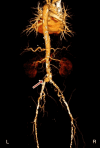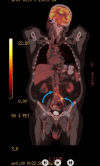Infectious Aortitis Following Peripheral Angiographic Catheterization
- PMID: 40718241
- PMCID: PMC12296743
- DOI: 10.7759/cureus.86869
Infectious Aortitis Following Peripheral Angiographic Catheterization
Abstract
Infectious aortitis and mycotic aneurysms are rare but potentially fatal conditions that often present with nonspecific symptoms, delaying diagnosis and treatment. The growing use of endovascular interventions has introduced new pathways for infection, particularly in high-risk individuals with vascular implants. We report the case of a 67-year-old man with coronary artery disease who developed persistent lower back pain and systemic symptoms following peripheral angiographic catheterization and covered iliac stent implantation. Blood cultures repeatedly grew Staphylococcus lugdunensis (S. lugdunensis), a virulent coagulase-negative staphylococcus known for its biofilm-forming capacity. CT angiography and 18F-fluorodeoxyglucose (FDG) PET-CT revealed an infected aortic pseudoaneurysm with perivascular inflammation, consistent with infectious aortitis and device-related infection. Despite targeted intravenous antibiotics, bacteremia persisted, indicating failure of conservative management. Surgical intervention was planned but ultimately declined by the patient, who deteriorated and passed away shortly after discharge. This case highlights a rare instance of S. lugdunensis-associated infectious aortitis arising from a covered iliac stent. The persistent bacteremia despite appropriate antibiotic therapy strongly suggests biofilm-mediated infection, underscoring the limitations of medical therapy alone in managing device-associated infections. PET-CT proved instrumental in detecting metabolically active infection when anatomical imaging was inconclusive. Clinicians should maintain a high index of suspicion for infectious aortitis in patients with vascular implants presenting with systemic symptoms and persistent bacteremia. Early use of PET-CT and timely multidisciplinary evaluation are essential for diagnosis and management. This report adds to the limited literature on peripheral stent-associated infections, particularly those caused by S. lugdunensis, and underscores the need for heightened post-procedural vigilance in similar cases.
Keywords: false aneurysm; infectious aortitis; percutaneous coronary intervention complications; sepsis; staphylococcus lugdunensis.
Copyright © 2025, Gerçek et al.
Conflict of interest statement
Human subjects: Informed consent for treatment and open access publication was obtained or waived by all participants in this study. Conflicts of interest: In compliance with the ICMJE uniform disclosure form, all authors declare the following: Payment/services info: All authors have declared that no financial support was received from any organization for the submitted work. Financial relationships: All authors have declared that they have no financial relationships at present or within the previous three years with any organizations that might have an interest in the submitted work. Other relationships: All authors have declared that there are no other relationships or activities that could appear to have influenced the submitted work.
Figures


Similar articles
-
123I-MIBG scintigraphy and 18F-FDG-PET imaging for diagnosing neuroblastoma.Cochrane Database Syst Rev. 2015 Sep 29;2015(9):CD009263. doi: 10.1002/14651858.CD009263.pub2. Cochrane Database Syst Rev. 2015. PMID: 26417712 Free PMC article.
-
Systemic Inflammatory Response Syndrome.2025 Jun 20. In: StatPearls [Internet]. Treasure Island (FL): StatPearls Publishing; 2025 Jan–. 2025 Jun 20. In: StatPearls [Internet]. Treasure Island (FL): StatPearls Publishing; 2025 Jan–. PMID: 31613449 Free Books & Documents.
-
Management of urinary stones by experts in stone disease (ESD 2025).Arch Ital Urol Androl. 2025 Jun 30;97(2):14085. doi: 10.4081/aiua.2025.14085. Epub 2025 Jun 30. Arch Ital Urol Androl. 2025. PMID: 40583613 Review.
-
[Guidelines for the prevention and management of bronchial asthma (2024 edition)].Zhonghua Jie He He Hu Xi Za Zhi. 2025 Mar 12;48(3):208-248. doi: 10.3760/cma.j.cn112147-20241013-00601. Zhonghua Jie He He Hu Xi Za Zhi. 2025. PMID: 40050074 Chinese.
-
Automated devices for identifying peripheral arterial disease in people with leg ulceration: an evidence synthesis and cost-effectiveness analysis.Health Technol Assess. 2024 Aug;28(37):1-158. doi: 10.3310/TWCG3912. Health Technol Assess. 2024. PMID: 39186036 Free PMC article.
References
-
- Surgical pathology of infected aneurysms of the descending thoracic and abdominal aorta: clinicopathologic correlations in 29 cases (1976 to 1999) Miller DV, Oderich GS, Aubry MC, Panneton JM, Edwards WD. Hum Pathol. 2004;35:1112–1120. - PubMed
-
- Recent advances in the diagnosis and therapy of large vessel vasculitis. Keser G, Atagunduz P, Soy M. Pol Arch Intern Med. 2022;132:16272. - PubMed
Publication types
LinkOut - more resources
Full Text Sources
